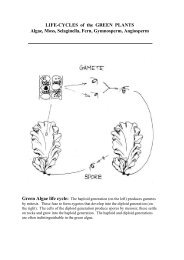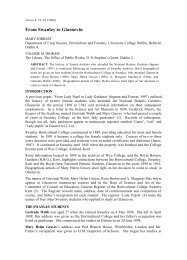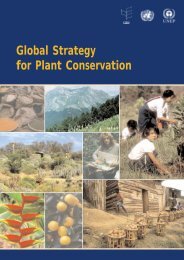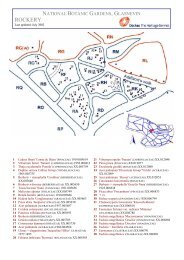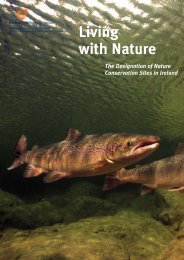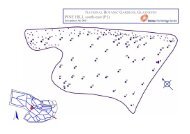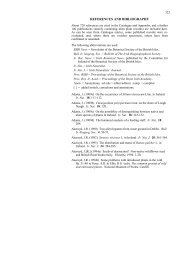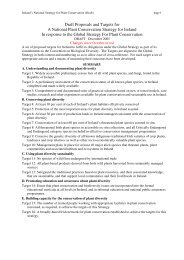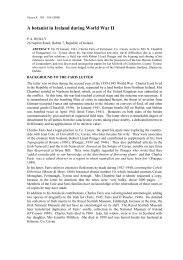Identification, Biology and Management of Elodea canadensis ...
Identification, Biology and Management of Elodea canadensis ...
Identification, Biology and Management of Elodea canadensis ...
- No tags were found...
You also want an ePaper? Increase the reach of your titles
YUMPU automatically turns print PDFs into web optimized ePapers that Google loves.
when the weed will disperse into areas unfavourable to itssurvival.Draining. Hejny <strong>and</strong> Husák (1978) comment that controlin Czechoslovakia is simply effected by a combination <strong>of</strong>summer <strong>and</strong> winter drainage. Winter frost also helps in theseclimates. In Australia, control is aided by draining <strong>and</strong> exposure<strong>of</strong> sediments to high summer temperatures or winterfrosts, but draining for sufficient time is not always feasible,especially in larger canals.Herbicides. E. <strong>canadensis</strong> is difficult to control with herbicides.Possible explanations include the protective effect <strong>of</strong>heavy coatings <strong>of</strong> bacteria <strong>and</strong> aufwuchs (detritus, algae, bacteria<strong>and</strong> inorganic particulates) on the leaves <strong>of</strong> the plants.The role <strong>of</strong> bacteria in protecting E. <strong>canadensis</strong> against diquatwas demonstrated by Whitfort (1982) using plants grownaxenically or colonized by Pseudomonas or Bacillus spp. Similarly,Bowmer (1982b) demonstrated that aufwuchs washedfrom the leaves <strong>of</strong> E. <strong>canadensis</strong> would contribute to the loss<strong>of</strong> toxic effect.Another problem is the difficulty <strong>of</strong> penetrating verydense weed beds with herbicides as described by Bowmer etal. (1985) in their attempts to control E. <strong>canadensis</strong> with terbutryne.Several herbicides seem to require long contacttimes for effective control, for example, fluridone (1-methyl-3-phenyl-5-[3-(trifluromethyl) phenyl]-4(1H)-pyridinone),endothal (7-oxabicyclo[2.2.1]heptane-2,3-dicarboxylic acid)<strong>and</strong> terbutryne (2-(tert-butylamine)-4-(ethylamino)-6-(methyl-thio)-s-triazine). This makes management difficultin flowing water. Herbicides preferred for their margins <strong>of</strong>safety for water users <strong>and</strong> aquatic life (for example the potassiumsalt <strong>of</strong> endothal) seem to be ineffective.Diquat (6,7-dihydrodipyrido[1,2-∝:2,1-c]pyrazinediium) <strong>and</strong>copper sulphate or chelates <strong>of</strong> copper can be used in static water.The addition <strong>of</strong> copper is reputed to improve control comparedwith diquat alone, <strong>and</strong> is also advantageous because algae areinhibited. Paraquat (1,1 1 -dimethyl-4,4 1 -bipyridinium(I)) <strong>and</strong>diquat mixtures are used in Czechoslovakia, but these promote thesubsequent growth <strong>of</strong> filamentous algae. Diquat is ineffective inturbid waters because it is inactivated by adsorption to soil particles(Bowmer 1982a).<strong>Elodea</strong> <strong>canadensis</strong>, Egeria densa <strong>and</strong> Hydrilla verticillata areknown to be sensitive to fluridone (McCorkelle et al. 1992a).But reliable control requires static water <strong>and</strong> the total treatment<strong>of</strong> a pond or lake. In slow-moving water the effectiveness<strong>of</strong> fluridone is reduced. Label recommendations arethat water bodies should be maintained static for at leastseven days after treatment to enable adequate uptake <strong>of</strong> herbicideby the plants. Use <strong>of</strong> fluridone in the irrigation channelsystems <strong>of</strong> Australia may be limited because <strong>of</strong> potentialdamage to susceptible crops, especially rice.Terbutryne is used for control <strong>of</strong> various submergedweeds including E. <strong>canadensis</strong> in Europe (Murphy 1982), <strong>and</strong>in Ontario (MacKenzie et al. 1983). For treatment <strong>of</strong> lakes<strong>and</strong> storages this compound has many advantages, whichinclude longer-term control <strong>of</strong> macrophytes, suppression <strong>of</strong>algae, <strong>and</strong> greater safety for non-target aquatic organismsincluding fish (Aston <strong>and</strong> Reynaert 1974). It has been consideredfor use in temperate lakes for control <strong>of</strong> Myriophyllumspicatum, but not <strong>Elodea</strong> <strong>canadensis</strong>. Treatment <strong>of</strong> flowingwater would be impractical because <strong>of</strong> the extensive contactFigure 5. Distribution <strong>of</strong> <strong>Elodea</strong> bifoliata (•), <strong>Elodea</strong> nuttallii (°) <strong>and</strong> <strong>Elodea</strong><strong>canadensis</strong> (▲) in North America (modified from Cook <strong>and</strong> Urmi-König 1985).time required for the herbicide to be effective (Bowmer et al.1985).Acrolein (acrylaldehyde) gives temporary control in flowingwater. It is injected into the water <strong>and</strong> allowed to flowover the weed beds. Application is restricted to approvedoperators. It is used in several States <strong>of</strong> North America,mainly in the Pacific Northwest, for treatment <strong>of</strong> a mixedspectrum <strong>of</strong> submerged weeds in irrigation distribution systems.In Australia, the sensitivity <strong>of</strong> different species in a trialwas Vallisneria spp. ><strong>Elodea</strong> <strong>canadensis</strong> >Potamogeton tricarinatus.Therefore repeated treatment may disadvantage thedesirable native Vallisneria, <strong>and</strong> favour the troublesome <strong>and</strong>obstructive native Potamogeton (Bowmer <strong>and</strong> Smith 1984).The optimisation <strong>of</strong> acrolein use, including the economy <strong>of</strong>multiple additions to compensate for rapid loss from flowingwater, is described by Bowmer <strong>and</strong> Sainty (1977).Bensulfuron methyl (Methyl 2[[[[[(4,6 dimethoxy pyrimidin-2-yl)amine]carbonyl]amino]sulfonyl]methyl]benzoate)showed great potential for control <strong>of</strong> Hydrilla verticillata byinhibiting tuber formation (Anderson <strong>and</strong> Dechoretz 1988).In Australia, <strong>Elodea</strong> <strong>canadensis</strong> is tolerant to bensulfuronmethyl (McCorkelle et al. 1992b). Bensulfuron methyl is theactive ingredient <strong>of</strong> both Londax ® , a herbicide used in riceproduction, <strong>and</strong> Mariner ® , a herbicide that was under evaluationfor use in aquatic environments. In late 1992, work onthe registration <strong>of</strong> Mariner ® was stopped because it had accumulatedtemporarily in freshwater clams, a monitoringorganism (Anon 1992).Other herbicides reported to be used in managementinclude:(i) for injection into flowing water: aromatic solvent <strong>and</strong>emulsifier; anhydrous ammonia; copper sulphate (dumpedor continuously fed into the water); <strong>and</strong> the liquid formulation<strong>of</strong> endothal alkylamine.(ii) for treatment <strong>of</strong> ponded water: ametryn (2-ethylamino-4-isopropylamino-6-methyl thio-1,3,5-triazine); anhydrousammonia; copper sulphate; endothal alkylamine (liquid orgranular formulations); hexazinone (3-cyclohexyl-6-(dimeth-J. Aquat. Plant Manage. 33: 1995. 17



